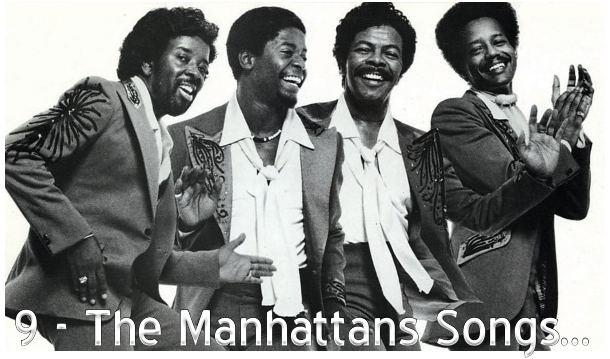(ThyBlackMan.com) The Manhattans defined what it means to blend heart and harmony into pure soul. From Jersey City to stages around the world, they transformed emotion into sound — crafting songs where smooth vocals, orchestral arrangements, and slow-burning grooves met poetic storytelling. Led by Gerald Alston, their blend of silky leads and rich background harmonies became a blueprint for romantic R&B.
Every track they recorded felt like a performance of sincerity, built on phrasing, balance, and tone. Their music wasn’t just sung — it was crafted, shaped carefully with melody and meaning. Decades later, those songs still resonate, their production lush but never dated, their emotion as sharp as ever.
This collection of nine Manhattans songs revisits moments when soul met sophistication — timeless performances that continue to show why their sound remains one of the purest expressions of R&B’s golden era.

1. “It Feels So Good to Be Loved So Bad”
This lush 1977 single captures The Manhattans in full stride. The opening orchestral sweep, courtesy of producer Bobby Martin, immediately sets the tone for an emotionally immersive experience. The strings swirl around Gerald Alston’s silky lead, while the rest of the group wraps their harmonies around him like velvet. It’s not just a love song—it’s a cinematic experience, complete with the gentle emotional push-and-pull that defined their most inspired work.
Lyrically, “It Feels So Good to Be Loved So Bad” epitomizes romantic surrender. The phrasing is pure poetry: lines like “You came into my life, made me feel alive” evoke both gratitude and awe. What makes it special is the emotional honesty—this isn’t a song about idealized perfection but about the deep comfort of being truly seen. The warmth of Alston’s voice gives life to every syllable, rising and falling like the breath of someone savoring a moment they once thought they’d never find.
Musically, the craftsmanship is unmatched. Bobby Martin’s arrangement blends horns, strings, and rhythm guitar into an opulent landscape of emotion. There’s a subtle jazz touch in the chord progression, while the bassline anchors everything with quiet confidence. Unlike the production excesses that came to dominate late ’70s R&B, The Manhattans’ restraint here allows the song to breathe. It’s slow, deliberate, and sensual without ever being showy.
Even in today’s musical landscape, “It Feels So Good to Be Loved So Bad” holds power. When played late at night—perhaps through headphones or a crackling vinyl—the intimacy still feels startlingly personal. It’s a reminder that true soul music isn’t just heard; it’s felt deep within the chest. The song stands as a bridge between eras—a masterclass in how tenderness, when paired with musical sophistication, never ages.
2. “We Never Danced to a Love Song”
Few ballads capture quiet heartbreak as beautifully as “We Never Danced to a Love Song.” It’s a lament for what never was, a portrait of love that faded before its moment arrived. The title alone suggests missed opportunities, and the delivery turns that regret into something poetic. The Manhattans transform emotional stillness into art, creating one of their most contemplative works.
Gerald Alston’s lead vocal sets the mood immediately—soft, reflective, and deeply human. His restraint is the song’s greatest strength. Instead of grand flourishes or vocal fireworks, he offers something far more intimate: confession. The harmonies, always the group’s secret weapon, move like a slow tide, cushioning his vulnerability with grace. The instrumentation—a blend of light percussion, quiet piano, and strings—adds atmosphere without distraction.
What makes the song resonate beyond its time is its lyrical maturity. It’s not about heartbreak from betrayal, but from neglect. When Alston sings, “We never danced to a love song, and you know it’s kind of sad,” he’s not angry—he’s acknowledging the emotional distance that can exist even in companionship. That kind of reflection is timeless. It’s a scenario anyone can recognize—the moment you realize love’s opportunities slipped quietly past.
Listening today, “We Never Danced to a Love Song” carries new layers. In an era of rushed relationships and digital affection, its message hits even harder. It warns against complacency, urging lovers not to let life’s rhythm drown out intimacy’s melody. It’s an eternal slow jam for reflection—a soundtrack for anyone who’s ever realized too late that love deserves participation, not just presence.
3. “Wish That You Were Mine”
“Wish That You Were Mine” is a masterstroke in expressing longing. The Manhattans always excelled at dignified emotion, and this track embodies that with rare precision. There’s a tenderness here that feels deeply personal—less like performance, more like a private confession set to music.
From the first note, the arrangement whispers melancholy. The gentle rhythm section—anchored by soft drums and warm bass—provides a cushion for the strings that float above like memories. The composition has an almost cinematic structure, building emotion slowly without ever spilling over. Gerald Alston’s delivery remains conversational, as though he’s speaking directly to one person, making the listener an intimate part of his world.
What elevates the song is its lyrical simplicity. There are no exaggerated metaphors or lyrical flourishes, just a man stating the plain truth: “I wish that you were mine.” In its honesty lies the song’s beauty. The Manhattans resist the urge to dramatize. Instead, they lean into sincerity—a move that has made this one of their most enduring ballads.
In a modern context, “Wish That You Were Mine” still resonates powerfully. Its vulnerability cuts through the detachment that often defines contemporary love songs. The track reminds us that longing, when expressed truthfully, doesn’t need embellishment—it needs courage. When heard today, especially through remastered clarity, its emotional texture feels just as fresh. It remains one of those rare pieces of soul music that feels both nostalgic and eternal.
4. “I Kinda Miss You”
Released in 1976, “I Kinda Miss You” is a slow jam that captures emotional subtlety better than almost any other R&B song of its time. The groove is smooth, restrained, and hypnotic. What The Manhattans accomplish here is deceptively difficult: they make melancholy sound seductive. The production—horns gliding over lush strings, anchored by a lightly funky rhythm—creates an atmosphere that is both mournful and intimate.
The lyrical understatement is what makes the song so unforgettable. To say “I kinda miss you” is to admit vulnerability while still clinging to pride. It’s the language of love in denial, of someone caught between letting go and holding on. That small word—“kinda”—carries layers of emotion: hesitation, regret, affection, and restraint. It’s how real people talk, and that authenticity gives the song its timelessness.
Gerald Alston’s vocal control is remarkable throughout. He never oversings; instead, he lets silence do part of the talking. The harmonies gently weave around him, creating an echo chamber of feeling. The instrumentation mirrors that emotional push and pull, alternating between warmth and distance.
When heard today, “I Kinda Miss You” feels like it could sit comfortably beside the work of artists like Snoh Aalegra, Maxwell, or Giveon. Its fusion of vulnerability and groove anticipates the quiet storm movement that would define late-night R&B in the decades that followed. The Manhattans’ ability to express complex feelings with such effortless sophistication is why their catalog remains essential listening for any serious lover of soul.
5. “Am I Losing You”
“Am I Losing You” captures that uneasy emotional space where love begins to fade but the heart refuses to accept it. The Manhattans approach this theme not with anger, but with confusion and fear—making it one of their most relatable tracks. It’s the sound of a man trying to keep something alive while feeling it slowly drift away.
The production is minimalist compared to their other lush ballads. A gentle piano line carries the melody, while soft percussion adds heartbeat-like tension, mimicking the anxious rhythm of a worried lover’s chest. There’s a haunting stillness that lingers between the notes, giving the song a cinematic intimacy. Gerald Alston’s tone—warm but weary—embodies vulnerability without breaking into despair. Each inflection feels like an internal conversation: What went wrong? Am I imagining this? Can we fix it?
What’s striking about “Am I Losing You” is its introspective tone. It doesn’t blame or beg—it wonders. That self-questioning quality makes it stand apart from typical breakup songs. The Manhattans treat love as a dialogue, not a monologue, and that humility gives the track emotional sophistication. Their harmonies—soft, shadowy, and precise—act like thoughts echoing in the background, giving the song a layered, reflective mood.
Even today, the song feels modern in spirit. It mirrors the uncertainty many couples face in an age where emotional disconnection often replaces confrontation. Whether played late at night during quiet reflection or through headphones during a lonely commute, it remains one of the most honest depictions of emotional fragility in soul music. “Am I Losing You” doesn’t just express fear of loss—it captures the courage to face it.
6. “Don’t Take Your Love”
“Don’t Take Your Love,” released in 1974, stands as one of The Manhattans’ most powerful emotional statements. It brims with urgency, the sound of love on the edge of collapse. Yet even in its desperation, it maintains the elegance that defines the group’s artistry. From the opening chord, listeners can feel the tension between pride and pleading—two emotional poles that define every great soul ballad.
The instrumentation is deliberate and dramatic: a slow-burning rhythm section, gently weeping guitar riffs, and restrained horns that add both sorrow and strength. Gerald Alston delivers one of his finest performances, alternating between silk and fire. His voice quivers with controlled emotion, never breaking but always trembling on the verge of tears. Behind him, the group’s harmonies provide a sense of moral support, as though his friends are standing behind him, willing love to stay.
The lyrical refrain—“Don’t take your love away”—is deceptively simple, yet it holds universality. Everyone who has ever feared abandonment understands its plea. The Manhattans elevate those words from mere begging to art. There’s grace in their desperation, a dignity in their longing that makes the track resonate decades later. It’s a perfect example of how the group could blend emotional honesty with refined delivery.
When played now, “Don’t Take Your Love” feels timeless because it embodies one of love’s most human moments—the fear of losing something precious. Its arrangement still feels rich and full, even by modern production standards. It’s not nostalgia that keeps it alive; it’s recognition. Every generation, no matter how evolved or detached, understands the ache of wanting love to last just a little longer.
7. “It’s You”
“It’s You” may not always be the first title mentioned in discussions of The Manhattans’ best work, but for true soul connoisseurs, it’s a hidden gem that captures the group’s core identity—romantic sincerity rendered in perfect harmony. The track unfolds with tender restraint, like a soft breeze through a candlelit room.
Musically, it’s a masterpiece of simplicity. The arrangement glides gently on a slow rhythm, tender strings, and subtle horns that shimmer rather than shout. The rhythm section anchors the sound, keeping everything smooth and controlled. Alston’s voice, drenched in gratitude, rises like a prayer. He sings not to impress, but to express—each word a confession of appreciation for love that’s real and steady.
Lyrically, “It’s You” is about gratitude. It’s a song for those who’ve finally found peace in love after years of searching or heartbreak. The Manhattans’ harmonies reinforce that sentiment with angelic precision. They echo Alston’s lines like echoes in a cathedral, amplifying the sacredness of genuine connection. There’s no flash, no theatrics—just feeling.
In a modern world of overproduced love songs, “It’s You” feels refreshingly honest. It proves that sometimes the softest declarations carry the most weight. The song could easily find its place on a wedding playlist today, nestled between Maxwell and Gregory Porter. It stands as a quiet lesson in timeless R&B storytelling: sincerity, not spectacle, is what keeps a love song alive.
8. “There’s No Me Without You”
“There’s No Me Without You” is The Manhattans’ magnum opus—a love song that transcends romance and ventures into the realm of devotion. Released in 1973, it remains one of their most cherished recordings, a spiritual declaration of emotional interdependence. Unlike songs that treat love as possession, this one treats it as identity.
The track opens with a haunting, cinematic melody that immediately commands attention. The orchestral arrangement swells like a tide, moving from gentle string flourishes to full symphonic power. Gerald Alston’s voice enters with unshakable conviction. He sings as though each lyric is sacred text, and in doing so, he turns vulnerability into strength. The harmonies wrap around his lead with tenderness, creating the sensation of being embraced by sound itself.
Lyrically, the song achieves poetic perfection. The phrase “There’s no me without you” captures the essence of love as unity rather than dependency. It’s about two souls existing as one without erasing individuality. The emotional structure of the song mirrors this balance: delicate verses that swell into a chorus of complete surrender.
Even today, its impact remains powerful. Played at weddings, anniversaries, or intimate gatherings, it never fails to evoke tears and reflection. Its analog warmth offers an antidote to modern detachment. “There’s No Me Without You” isn’t just a romantic anthem—it’s a life philosophy set to music, reminding us that connection is what gives life its meaning.
9. “Girl of My Dream”
“Girl of My Dream” closes this list with a tenderness that encapsulates everything The Manhattans stood for—romantic optimism, emotional purity, and vocal mastery. The track feels like a gentle farewell kiss, a dream you wish would never end.
Musically, it’s stunning in its restraint. The flute dances lightly over the melody while strings glide beneath in lush waves. The percussion is soft, almost invisible, creating a floating rhythm that perfectly supports the song’s dreamy theme. The harmonies shimmer, glowing with warmth and grace. Alston’s voice, as always, is the centerpiece—gentle, honest, and deeply human.
The lyrics are simple but profound, describing the beauty of finding one’s ideal partner without veering into fantasy. When Alston sings of the “girl of my dream,” it’s not about perfection—it’s about gratitude for real love that feels divine. That humility gives the song its grounding power. The group’s chemistry, built from years of shared experience, shines here; you can feel the trust and unity in every layered vocal.
From a critical standpoint, “Girl of My Dream” represents the rare balance The Manhattans achieved between realism and romanticism. They never exaggerated emotion—they articulated it. Even now, it feels relevant. Whether playing during a quiet evening at home or as the soundtrack to a couple’s first dance, it conveys an eternal truth: love, when sincere, always feels like a dream you don’t want to wake from.
The Manhattans didn’t rely on gimmicks or trends; they built their sound on emotional precision and vocal craftsmanship. Each of these nine songs demonstrates their rare ability to make love songs sound both classic and contemporary. In every harmony, there’s warmth; in every lyric, there’s honesty.
Listening to their music today isn’t just an act of nostalgia—it’s a reaffirmation of soul music’s timeless ability to articulate what words alone often cannot. Whether you’re revisiting these songs or discovering them for the first time, The Manhattans remind us that love—expressed through melody—never ages.

















You missed the number 1. Song “LET’S JUST KISS and SAY GOODBYE”